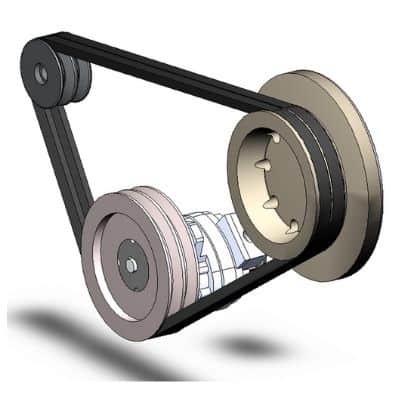In Brief: Direct Drive vs Belt Drive Table Saw
The biggest choice you will make when buying a table saw is the drive type. Direct drive table saws are inexpensive, portable, and maintenance-free. Belt drive table saws are professional-grade, powerful, and safe. This guide will help you decide which tool is right for you.
A wide variety of table saws are available these days. They come in many styles and types, but probably the most vital decision you will need to make is whether to go with a direct-drive or belt drive table saw.
You cannot change your drive system at a later date, so it is vital to get it right now.
This guide will run down the differences in these two types of table saw drive system and help you decide which best suits your needs.
Differences Between Direct Drive and Belt Drive Table Saws
| Feature | Direct Drive Table Saw | Belt Drive Table Saw |
|---|---|---|
| Price | Relatively cheap. | Relatively expensive. |
| Design | Motor attached to saw blade. | Motor attached via v-belt and pulley system. |
| Portability | Smaller, so more portable. | Larger, so less portable. |
| Power | Less powerful but more efficient. | Less efficient but more powerful. |
| Noise | Quieter. | Louder. |
| Materials | Wood of limited thickness and size. | Thick hardwood of larger dimensions. |
| Maintenance | Low maintenance. | Belts require maintenance and replacement. |
| Safety | Risk of kickback and overheating. | Relatively safe. |
How It Works
Table saws utilize a circular saw blade that protrudes through a large work surface. You move the material through the saw blade to perform a cut.
Direct drive table saws use a motor that is attached directly to the saw blade, so all the power produced transfers to it, leading to greater efficiency.
Belt drive table saws move the motor away from the saw blade and use a v-belt and pulley system to transfer the power between them. It loses efficiency in the process, but the larger motor mitigates this.
When To Use
Direct drive table saws are great for home woodworkers and people who require portability. The direct drive table saw is more compact, cheaper and easier to maintain than belt drive models.
Belt drive table saws include a pulley system that necessarily takes up more space. As a result, these table saws are far more stationary. The added space requirements and the inability to move them around means that they are more suitable for large workshops.
Professional woodworkers have more cause to buy a belt drive table saw than the average DIYer or hobbyist.
The increased power of the belt drive system means that it can handle thicker and harder pieces of wood that direct-drive counterparts.

Portability
If you require portability for your table saw, a direct drive system will be better suited to your needs.
The motor attaches directly to the blade so the work surface can be much smaller. You can commonly find direct drives on the portable table saws intended for workers who need to transport it between work sites.
Belt drives have a lot more machinery. As a result, the whole table saw tends to be much larger. They are common in cabinet models.
If you do all your woodworking in one place and therefore do not need portability, a belt drive system might be better suited for your needs.
Power
Belt drive table saws are higher powered than direct drive saws, which might seem counterintuitive.
The belt and pulley system on belt drives is less efficient than on a direct drive system, but the larger motor fitted on belt drives outweighs the lost efficiency.
A typical direct-drive motor will generate 1-2 horsepower, whereas a belt-drive motor will generate 3-5 horsepower.
The significant difference in power has a direct effect on the types of materials you can cut. A direct drive table saw will be limited to around 2” thickness, whereas a belt drive table saw can handle far thicker pieces of hardwood.
Noise
Direct drives tend to be louder than belt drive table saws, despite their relatively low power.
While it is generally true that larger motors produce more noise, you must also take into account whether that noise is absorbed.
Belt drive systems absorb a lot of the noise into the belts. The absorption reduces noise and vibration, making them more suitable if you need a quieter machine.
Direct drive systems have no way of absorbing sound because the motor is attached directly to the saw blade.
Materials
The relatively high power of the belt drive table saw means that it is capable of producing high-precision cuts in a greater variety of materials.
An underpowered saw will struggle to cut through harder and thicker materials. If you try to do it anyway, it could result in uneven cuts.
The larger work surface on a belt drive table saw also accommodates larger material dimensions.
On a portable direct-drive table saw intended for being transported between worksites, the working surface will be significantly smaller and unable to make clean cuts in long, wide boards.
Price
Belt drive table saws are larger and more mechanically complex than direct drive table saws. The motors are larger, more powerful, and designed for use by professionals.
All of this means that you will pay significantly more for a belt drive table saw.
Maintenance
Belt drive table saws require more maintenance than direct drive table saws. However, they tend to last longer.
You will need to replace the belt on a belt drive system when it wears. They are typically quite sturdy, so this is not a frequent occurrence.
On the other hand, direct-drive table saws have fewer mechanical parts and therefore require less maintenance.
The caveat is that, because direct drives have the motor so close to the saw blade, the build-up of sawdust around the motor will increase the rate of failure. This means that direct drives have a lower life expectancy than belt drives.
Safety
The fact that direct drives suffer far more from sawdust build-up means that they can get very hot. This is a clear safety concern that you need to be aware of if you buy one.
There is also a greater risk of kickback due to lack of power. If you attempt to cut through material that is too hard or thick for the motor then you risk the blade carrying the wood rather than cutting it, causing the kickback.
Belt drive table saws are also more expensive and, as such, often come with extra safety features as standard.
What Is A Direct Drive Table Saw?
A direct drive table saw is a work surface with a circular saw protruding through a slit. The saw blade is powered directly by an attached motor.
They are more compact and less expensive, making them suitable for woodworkers on the move.
However, they also lack power, which can be a problem if you need to cut thick pieces of hardwood. Their limited size also means the dimensions of the material you are cutting will be limited.
What Is A Belt Drive Table Saw?
A belt drive table saw is a work surface with a circular saw protruding through a slit. The saw blade is powered by a motor that is attached by a belt and pulley system on the underside of the work surface.
They are geared towards professionals and tend to be stationary tools.
They boast increased power and often come with extra safety features. However, they are more expensive and require more maintenance than direct drive alternatives.
Summary
Now that you understand the differences between these two types of table saw, you should be able to make a confident choice over which to purchase for your next project. With all the variation in modern power tools, we are glad to help guide you through the process.
If you have any more questions, or you just want to share your next project with the community, why not leave a comment in the section below?


